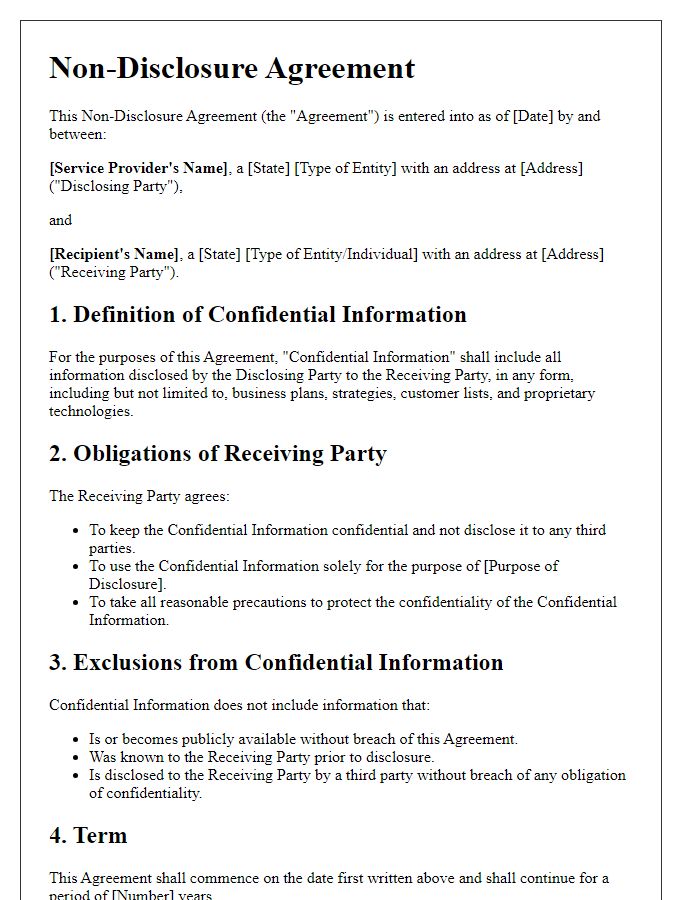Are you considering entering into a partnership with a vendor but worried about sharing sensitive information? A well-crafted non-disclosure agreement (NDA) is essential to protect your business interests and ensure confidentiality. In this article, we'll guide you through a comprehensive letter template that streamlines the NDA process, making it easier for both parties to understand their responsibilities. So, let's dive in and explore how you can safeguard your valuable information with the right NDA!

Confidential Information Definition
Confidential information in a vendor non-disclosure agreement encompasses sensitive data related to business operations, proprietary technology, trade secrets, and financial projections. This may include technical specifications of products under development, customer lists with associated demographics, marketing strategies outlining competitive positioning, and internal communication exchanges. The definition also covers, but is not limited to, documents, presentations, and software code that exhibit a company's unique practices and methodologies. Protecting this information is crucial as leaks can lead to significant competitive disadvantages and financial losses. The scope of confidential information should also consider verbal disclosures, electronic communications, and any third-party data that is shared during the duration of the partnership.
Obligations of Receiving Party
The obligations of the Receiving Party in a vendor non-disclosure agreement (NDA) encompass a set of critical responsibilities aimed at protecting the Confidential Information shared by the Discloser. The Receiving Party must ensure strict confidentiality, refraining from disclosing any proprietary information learned during the course of the business relationship. This includes, but is not limited to, sensitive data, trade secrets, financial projections, client lists, or product specifications. The Receiving Party must implement reasonable measures to safeguard the information, such as secure data storage and restricted access only to authorized personnel. Additionally, upon termination of the agreement or at the request of the Discloser, the Receiving Party is obliged to return or destroy all copies of the Confidential Information. Breach of these obligations can result in significant legal ramifications, including monetary damages or injunctive relief sought by the Discloser. The relationship is defined within the jurisdictional framework established by applicable laws, emphasizing the importance of compliance in all interactions.
Term and Termination
A vendor non-disclosure agreement (NDA) typically includes various components, with the "Term and Termination" section specifying the duration of the agreement and conditions under which it may be terminated. The term may typically extend for a specified number of years, such as five years, from the effective date, ensuring ongoing protection of confidential information. Termination conditions may include mutual consent, breach of agreement, or completion of the purpose for which the disclosure was made. Specific notice requirements (e.g., 30 days written notice) may also be outlined. Any obligations pertaining to the handling of confidential information post-termination, such as returning or destroying said information, should be clearly defined to protect intellectual property rights and sensitive data.
Exclusions from Confidentiality
Confidentiality agreements (also known as NDA) typically include specific exclusions to ensure clarity on what information does not fall under confidential protection. Exceptions often include information already publicly known, information disclosed by third parties not bound by confidentiality, details independently developed by the receiving party without reference to the disclosed confidential information, and disclosures required by law or court orders such as subpoenas. These exclusions aim to protect both parties involved while ensuring compliance with legal obligations and maintaining the integrity of shared information in a professional context.
Governing Law and Jurisdiction
A vendor non-disclosure agreement (NDA) often specifies the governing law and jurisdiction to provide legal clarity and framework for any disputes that may arise during the contract's enforcement. Typically, this clause will indicate the state or country whose laws will govern the agreement, such as the laws of California or New York. The jurisdiction aspect designates the location where any legal proceedings must be filed, ensuring both parties are aware of where they would need to go to resolve conflicts. For instance, if New York law governs the agreement, any disputes would be resolved in the courts of New York County. This specification ensures predictability and uniformity in interpretation and enforcement of the contract terms, which is crucial for maintaining confidentiality and safeguarding sensitive information exchanged between the vendor and the other party.













Comments